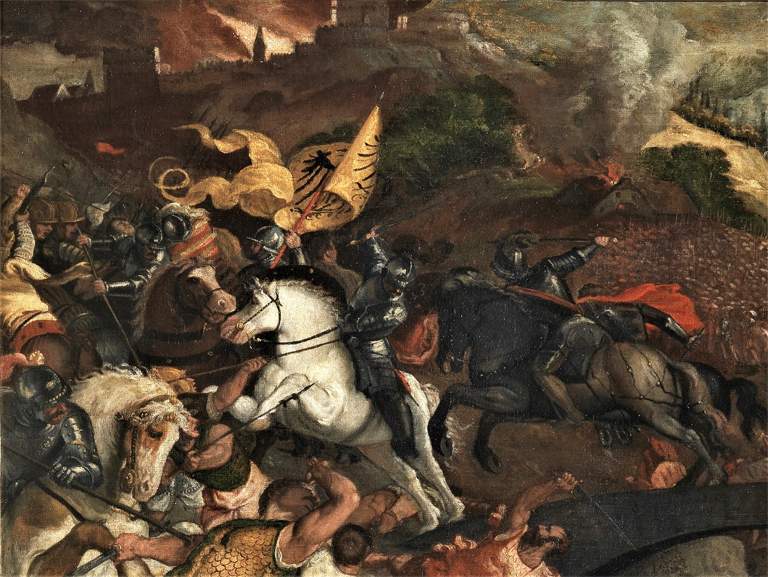The Magnificent Community of Cadore, for the fifth consecutive summer, is offering citizens and tourists a dossier exhibition that delves into the history and identity of the area through the art and appeal of one of its most celebrated artists, Titian Vecellio.
So, from July 10 to September 19 in the Birthplace of Titian Vecellio in Pieve di Cadore (Belluno) one can visit the exhibition La Battaglia di Cadore. History, contexts, copies from Titian: this is a narrative that develops around the painting Battaglia (mid-16th century), attributed to the Venetian Leonardo Corona (or, at any rate, to a painter of the Venetian school), obtained on loan from the Uffizi Galleries in Florence, which is a copy of a telero (vast pictorial compositions on canvases, brought together in historical-narrative cycles, which became in the 15th and 16th centuries the preferred wall decoration in Venice) made by Titian and destroyed during the burning of the Doge’s Palace in Venice in 1577. A small section with paintings by 20th-century authors is also housed in the Municipal Palace of Valle di Cadore.
A page of history marking a double anniversary. The summer 2021 exhibition activity is part of the national celebrations promoted for the 1,600th anniversary of the founding of the city of Venice while at the same time giving continuity to the activity of analysis, study and promotion of the centuries-old relationship between Cadore and the Serenissima Republic, a theme that has been deepened in recent years and at the center of local historical debate. Moreover, five hundred years after the dispute of one of the most important battles in modern history, which changed the fate and power games in the European scenario, the clash that took place precisely in Cadore, on March 2, 1508, in the surroundings of Valle di Cadore, in the locality of Rusecco, and which pitted against each other the imperial army of Maximilian I and the Venetian army captained by the famous condottiere Bartolomeo D’Alviano; it is an episode well known to the military and political history ofEurope at the beginning of the sixteenth century, and already Macchiavelli and Guicciardini grasped its importance.
Titian, who was born in Pieve di Cadore, offered to execute, as early as 1513, a canvass having as its subject the depiction of the Battle, destined for the Sala del Maggior Consiglio in the Doge’s Palace in Venice, having Leonardo ’s Battle of Anghiari and Michelangelo’s Battle of Cascina well in mind. However, delivery did not take place until August 1538, and the work was short-lived as it was burned in the fire of 1577, an event that devastated the entire palace.
To infer the appearance of the work today one must therefore rely on other sources such as preparatory drawings, prints, a later drawing by Rubens, and precisely the coeval oil-on-canvas pictorial copy by Leonardo Corona.
The Battle of Cadore, a work of great value and an extraordinary historical document, arrived at Palazzo Pitti in the seventeenth century thanks to Cardinal Leopoldo de’ Medici, and has left Florence in recent decades for only a few exhibitions, in Venice, Pordenone, and Japan. Critics from the 19th century to the present have attempted, through heraldic identification of the flags, to determine which battle the painting refers to, but despite the various hypotheses still no one has come to a certain definition.
In order to construct the exhibition dossier, a search for sources was undertaken that ranged not only in the Veneto region, but throughout Italy and even Europe. At the center of the exhibition is the authoritative loan of the canvas usually kept in the storerooms of the Uffizi Galleries in Florence, and it is flanked by an engraving of the Battle of Cadore by Fontana, and other historical evidence relating to the battle.
Titian’s birthplace is located in the heart of Pieve di Cadore, and at the time of its construction in the 15th century, it represented the typical home of a distinguished local family, which included, among its members, prestigious figures: notaries, lumber merchants, and those in charge of public affairs. Today’s building consists of two masonry floors, with an irregular floor plan, balconies, an exterior wooden staircase, and a pitched roof with a scàndole covering. On the first floor is the large room with wooden log floor used for exhibitions. Climbing the steep wooden staircase, you enter the upper floor, in the five evocative rooms where Titian probably spent his childhood and later, after his move to Venice, stayed whenever he returned to his homeland.
For all information you can visit the official website of the Magnifica Comunità di Cadore.
 |
| The Battle of Cadore according to Titian stars in an exhibition in Pieve di Cadore |
Warning: the translation into English of the original Italian article was created using automatic tools. We undertake to review all articles, but we do not guarantee the total absence of inaccuracies in the translation due to the program. You can find the original by clicking on the ITA button. If you find any mistake,please contact us.